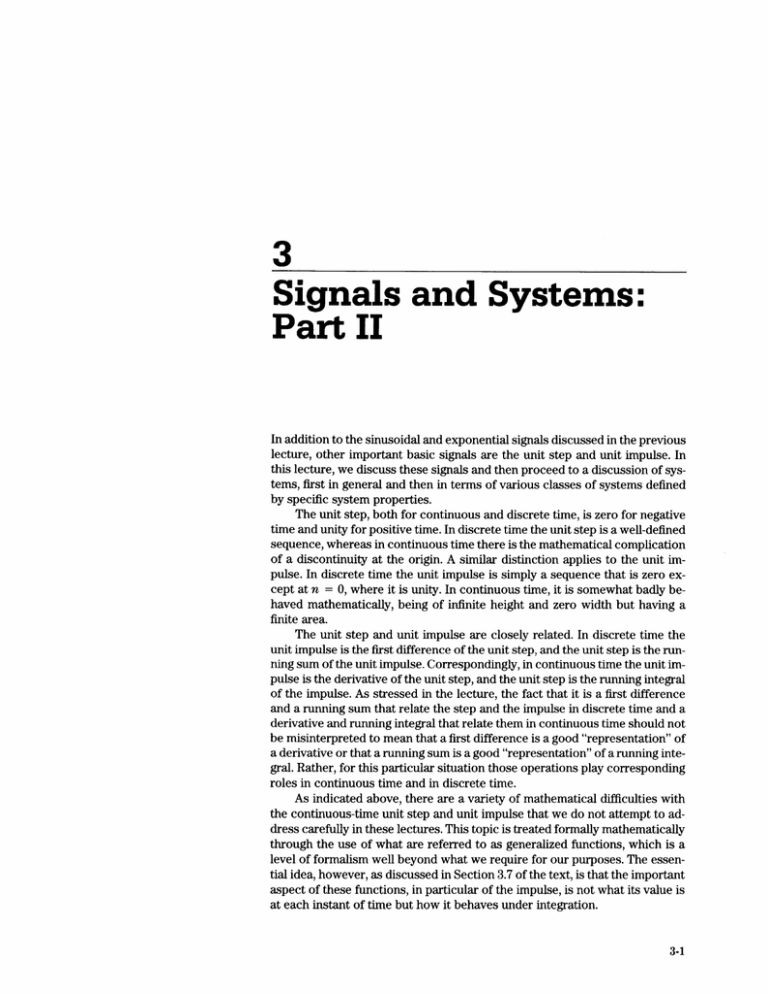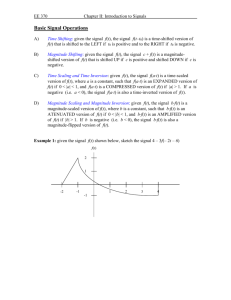3 Signals and Systems: Part II
advertisement

3
Signals and Systems:
Part II
In addition to the sinusoidal and exponential signals discussed in the previous
lecture, other important basic signals are the unit step and unit impulse. In
this lecture, we discuss these signals and then proceed to a discussion of systems, first in general and then in terms of various classes of systems defined
by specific system properties.
The unit step, both for continuous and discrete time, is zero for negative
time and unity for positive time. In discrete time the unit step is a well-defined
sequence, whereas in continuous time there is the mathematical complication
of a discontinuity at the origin. A similar distinction applies to the unit impulse. In discrete time the unit impulse is simply a sequence that is zero except at n = 0, where it is unity. In continuous time, it is somewhat badly behaved mathematically, being of infinite height and zero width but having a
finite area.
The unit step and unit impulse are closely related. In discrete time the
unit impulse is the first difference of the unit step, and the unit step is the running sum of the unit impulse. Correspondingly, in continuous time the unit impulse is the derivative of the unit step, and the unit step is the running integral
of the impulse. As stressed in the lecture, the fact that it is a first difference
and a running sum that relate the step and the impulse in discrete time and a
derivative and running integral that relate them in continuous time should not
be misinterpreted to mean that a first difference is a good "representation" of
a derivative or that a running sum is a good "representation" of a running integral. Rather, for this particular situation those operations play corresponding
roles in continuous time and in discrete time.
As indicated above, there are a variety of mathematical difficulties with
the continuous-time unit step and unit impulse that we do not attempt to address carefully in these lectures. This topic is treated formally mathematically
through the use of what are referred to as generalized functions, which is a
level of formalism well beyond what we require for our purposes. The essential idea, however, as discussed in Section 3.7 of the text, is that the important
aspect of these functions, in particular of the impulse, is not what its value is
at each instant of time but how it behaves under integration.
Signals and Systems
3-2
In this lecture we also introduce systems. In their most general form, systems are hard to deal with analytically because they have no particular properties to exploit. In other words, general systems are simply too general. We
define, discuss, and illustrate a number of system properties that we will find
useful to refer to and exploit as the lectures proceed, among them memory,
invertibility, causality, stability, time invariance, and linearity. The last two,
linearity and time invariance, become particularly significant from this point
on. Somewhat amazingly, as we'll see, simply knowing that a system is linear
and time-invariant affords us an incredibly powerful array of tools for analyzing and representing it. While not all systems have these properties, many do,
and those that do are often easiest to understand and implement. Consequently, both continuous-time and discrete-time systems that are linear and timeinvariant become extremely significant in system design, implementation, and
analysis in a broad array of applications.
Suggested Reading
Section 2.4.1, The Discrete-Time Unit Step and Unit Impulse Sequences, pages
26-27
Section 2.3.2, The Continuous-Time Unit Step and Unit Impulse Functions,
pages 22-25
Section 2.5, Systems, pages 35-39
Section 2.6, Properties of Systems, pages 39-45
Signals and Systems: Part II
TRANSPARENCY
3.1
Discrete-time unit step
and unit impulse
sequences.
S[n
u [n] -u[n-i]
u [n]
0
O0I
n
u [n - I]
u [n]-u [n-1]
TRANSPARENCY
3.2
The unit impulse
sequence as the first
backward difference
of the unit step
sequence.
Signals and Systems
3-4
n
u[n]=
8[m]
S
ms-C(
TRANSPARENCY
3.3
The unit step sequence
as the running sum of
the unit impulse.
n <0
8 Im]
n
O
n>O
8[Im]
TRANSPARENCY
3.4
The unit step sequence
expressed as a
superposition of
delayed unit impulses.
Signals and Systems: Part II
UNIT STEP FUNCTION: CONTINUOUS -TIME
u (t)=
{0
t < 0
t >0
TRANSPARENCY
u(t )
3.5
The continuous-time
unit step function.
t
0
t
O(
u(t) = u(t) as A -
0
UNIT IMPULSE FUNCTION
TRANSPARENCY
3.6
6(t)
-du(t)
The definition of the
unit impulse as the
derivative of the unit
step.
d
dt
duA(t)
5(t)
6(t)
dt
= 5A(t) as
A--0
Signals and Systems
3-6
t)
TRANSPARENCY
3.7
Interpretation of the
continuous-time unit
impulse as the limiting
form of a rectangular
pulse which has unit
area and for which
the pulse width
approaches zero.
A
area
=
I
8 (t)
height = " 00 "
width = "0"
o
k8(t)
TRANSPARENCY
3.8
The unit step
expressed as the
running integral of the
unit impulse.
t
area
=
I
Signals and Systems: Part II
3-7
Continuous -time
system
x (t )
TRANSPARENCY
3.9
Definition of a system.
x (t)
-
10y (t )
y(t)
0
y [n]
x[n]
x[n]
y[n]
-e
Cascade
TRANSPARENCY
3.10
Interconnection of
two systems in
cascade.
XI
O
yI
System
xi
yI
y
~ I
Y2a X1
yI
Signals and Systems
TRANSPARENCY
3.11
Interconnection of
two systems in
parallel.
feedback
TRANSPARENCY
3.12
Feedback interconnection of two
systems.
xI
x2 =
x+y2
Signals and Systems: Part II
MARKERBOARD
3.1
T N\ ERTAILMT(
6n(FYI Y-
LO
C
, AC
C4k
C-=E39
Xr~3
t
d~~c
P.
ML'
P 10(tA
-V
-t
?
T=crse o1 A
s*'0
'\
N
~y)
Aeo
"e
ss.
MARKERBOARD
3.2
Co
kA%'Q4'
epevsJi
on
Eva"'
Ie-.
-z> -For everbouvded
Pe ;o r
or*
om,Iud
+0
*
Ir3
CXn&-,3
txt
x Lo3
At
l
i
Et7)
Jrex\
input 'de o ,p
d
Time
b outnd ed
Or .
S4s4cm can,'t aAtic.,(AA
ft.t
-i-i-TILL--- ~rL'
or *
L-A2
A,C4 --
I'
~
y+)IM
7'A
(T)J-L
'Z C+)
+
ILVl . I j-Atr alGO11,LM)
11,0111-1
Same Fo
TI me
da5rttv-
S4-obe.
i
Signals and Systems
3-10
DEMONSTRATION
3.1
Illustration of an
unstable system.
MARKERBOARD
3.3
STvnvariaic.
c (t)-w
C-.. 4 OTr
~)C.h1hpk
t)
O4
b
0 )
,6,ts'cawst
Lo
(~C~
Iyy3: ~
I Me Tvarw~
,
Tvt1frl'w
__j
MIT OpenCourseWare
http://ocw.mit.edu
Resource: Signals and Systems
Professor Alan V. Oppenheim
The following may not correspond to a particular course on MIT OpenCourseWare, but has been
provided by the author as an individual learning resource.
For information about citing these materials or our Terms of Use, visit: http://ocw.mit.edu/terms.



![[ ] [ ] ( )](http://s2.studylib.net/store/data/011910597_1-a3eef2b7e8a588bc8a51e394ff0b5e0e-300x300.png)